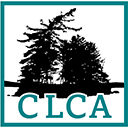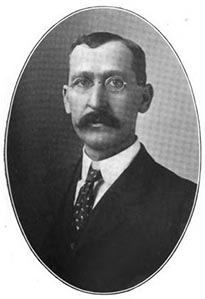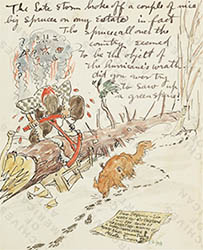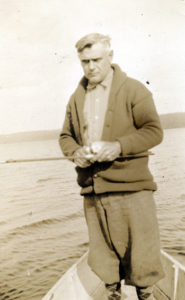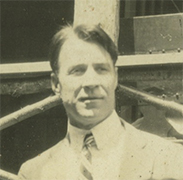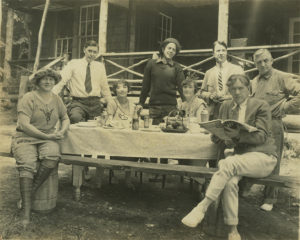 The picture above shows a picnic at the Russell camp in the late 1920s or early 1930s. Included are many of the notable people of the Lake during this period. From left to right are Nell Stanley, Paul Bransom, Evangeline (Van) Russell, Jim Stanley, Lu Russell, John Russell, Dwig, and George Streeter. Brief biographies of many of these and those of other notables were included in an Echo article by Eleanor Franz. This article is the foundation for what follows. For more detailed study see Barbara McMartin’s excellent book, Caroga, An Adirondack Town Recalls Its Past.
The picture above shows a picnic at the Russell camp in the late 1920s or early 1930s. Included are many of the notable people of the Lake during this period. From left to right are Nell Stanley, Paul Bransom, Evangeline (Van) Russell, Jim Stanley, Lu Russell, John Russell, Dwig, and George Streeter. Brief biographies of many of these and those of other notables were included in an Echo article by Eleanor Franz. This article is the foundation for what follows. For more detailed study see Barbara McMartin’s excellent book, Caroga, An Adirondack Town Recalls Its Past.
Alfred Dolge, 1848-1922
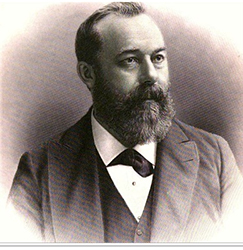 German immigrant who developed a diversity of industries including the manufacture of felt and felt slippers in Dolgeville. He devised a model for Social Security. His planning included the purchase of 5000 acres around 5 Canada Lakes for $600,000 in 1892. He was a frequent visitor to this tract where he developed electrical power, timber management and laid out cottage lots. After his bankruptcy the area was sold for $29,000 in 1904.
German immigrant who developed a diversity of industries including the manufacture of felt and felt slippers in Dolgeville. He devised a model for Social Security. His planning included the purchase of 5000 acres around 5 Canada Lakes for $600,000 in 1892. He was a frequent visitor to this tract where he developed electrical power, timber management and laid out cottage lots. After his bankruptcy the area was sold for $29,000 in 1904.
Teacher, postmaster, elected to 60th Congress in the 25th New York District. In 1904 he and three other men bought Dolge’s holdings around the Canada Lakes. The Durey Land and Lumber Co. sold many of the lots. He worked for a new power dam at Stewart’s Landing. Eventually after logging he sold the rest of the land to the Adirondack Forest Preserve for $4 an acre.
Clare Victor Dwiggins, 1874-1958
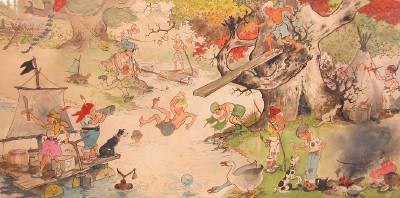
Born in south Ohio. At 16 he worked in an architect’s office. He became a noted cartoonist. Lived in Hollywood and at Canada Lake. With his wife Betsey, built the Dwigwam in 1907. Started Artists’ and Writers’ Colony and brought the following six friends to Canada Lake.
Born in Chicago of Bohemian parents. Illustrated for Colliers, Scribners, Harpers, and Judge. In 1908 with wife Grace Jones visited Dwig at Canada Lake and in 1912 bought 5 lots at $100 apiece from Cy Durey. Summered here for 50 years. In 1980 Caroga Historical Society showed 73 of his paintings. largely watercolors.
Paul Bransom, 1885-1979
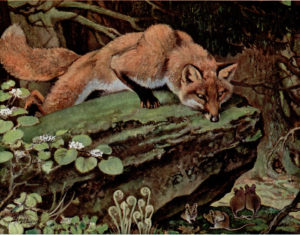 The dean of American animal artists”. Illustrated for Cosmopolitan, Good Housekeeping, and such books as Call of the Wild and Wind in the Willows. Had more than 80 awards and an Honorary Doctor of Arts from Weber State College, Ogden, Utah. First rented cottage next to Dwig. In 1917 he and wife Grace Bond bought 2 lots for $400 from Cy Durey. They later spent 17 summers at Jackson Hole, but Paul returned to Canada Lake after the death of his wife.
The dean of American animal artists”. Illustrated for Cosmopolitan, Good Housekeeping, and such books as Call of the Wild and Wind in the Willows. Had more than 80 awards and an Honorary Doctor of Arts from Weber State College, Ogden, Utah. First rented cottage next to Dwig. In 1917 he and wife Grace Bond bought 2 lots for $400 from Cy Durey. They later spent 17 summers at Jackson Hole, but Paul returned to Canada Lake after the death of his wife.
Reported for New York Herald Tribune. Author of numerous books including Gangs of New York and Barbary Coast. First wife, Helen, second wife Edith Evans Asbury, also a New York reporter. Brought to Canada Lake by Dwig’s wife Betsey. Owned a cottage on Dolgeville Point. [Editor’s note: 2002 Echo article by Bill Ringle describes Asbury’s colorful life. Martin Scorcese’s 2002 film Gangs of New York, based on Asbury’s 1927 book, won much critical acclaim.]
Willis Todhunter Ballard, 1903-1980
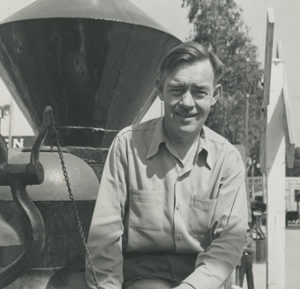 Author of 120 published books of fiction. His wife, Phoebe Greenlake Dwiggins, collaborated with him. Their Gold in California won 1965 Green Spur Award from Western Writers of America. Phoebe had grown up by Canada Lake in her parents’ cottages. They eventually built a camp on the South Shore and used it 5 years, then moved to another on the North Shore approachable by land. Phoebe died in 1993. She was born July 31, 1910.
Author of 120 published books of fiction. His wife, Phoebe Greenlake Dwiggins, collaborated with him. Their Gold in California won 1965 Green Spur Award from Western Writers of America. Phoebe had grown up by Canada Lake in her parents’ cottages. They eventually built a camp on the South Shore and used it 5 years, then moved to another on the North Shore approachable by land. Phoebe died in 1993. She was born July 31, 1910.
From South Dakota, he formed Blazed Trail Productions to produce western films in the town of Caroga. Along with his wife Lu Case and their two children Evangeline and John Jr., he had a camp next to the “Dwigwam” on the South Shore. Lu wrote the scripts, John played the hero, and Evangeline played the ingenue.
James Stanley, n.d.
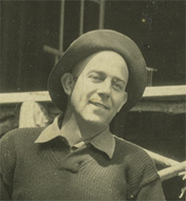 Metropolitan opera singer who had to give up his career because of throat cancer, after which he developed the Stanley Piano Lights in Nyack. Came to lake with wife, Nell, through Dwig’s influence and built a cabin on South Shore. Married a second time to Margaret. His daughter preferred the North Shore so he sold his first camp to Vincent and Mabel Kane in 1952 and moved to Kasson Drive.
Metropolitan opera singer who had to give up his career because of throat cancer, after which he developed the Stanley Piano Lights in Nyack. Came to lake with wife, Nell, through Dwig’s influence and built a cabin on South Shore. Married a second time to Margaret. His daughter preferred the North Shore so he sold his first camp to Vincent and Mabel Kane in 1952 and moved to Kasson Drive.
James Thurber, 1894-1964
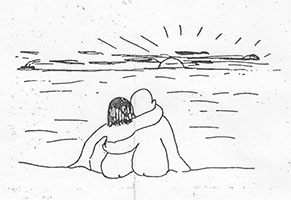 Writer for Paris Herald. Later wrote prolifically for The New Yorker and published books. Wife Althea also a writer for Paris Herald. They camped at Dwig’s and also visited James Stanley.
Writer for Paris Herald. Later wrote prolifically for The New Yorker and published books. Wife Althea also a writer for Paris Herald. They camped at Dwig’s and also visited James Stanley.
Mabel Cleland Widdemer, 1893-1964
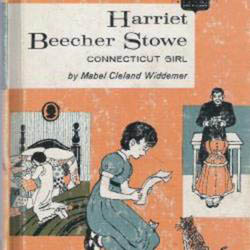 Writer of adult fiction and extremely popular biographies of the childhood of famous Americans. These books were found in many school libraries. With husband Kenneth Widdemer purchased Bud Shannon’s camp in 1921. In 1928 they built a cottage on Mud Lake for Margaret Widdemer. Son John still a summer resident of the lake.
Writer of adult fiction and extremely popular biographies of the childhood of famous Americans. These books were found in many school libraries. With husband Kenneth Widdemer purchased Bud Shannon’s camp in 1921. In 1928 they built a cottage on Mud Lake for Margaret Widdemer. Son John still a summer resident of the lake.
Margaret Widdemer, 1887-1978
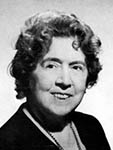
Published over 40 novels including a popular trilogy on Sir William Johnson, using the Johnson papers. Won Pulitzer Prize for Poetry with “Old Road to Paradise” in 1919. Co-director of Chautauqua meeting and organizer of Bread Loaf Conference. Spent many summer at her cottage on Mud Lake.
Harold Henry Schumacher, 1911-1993
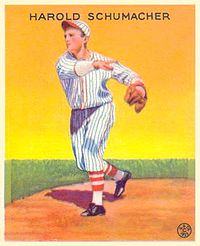 Born in Hinckley. New York Giants pitcher from 1931-1942 and 1946, after three years in military service in Pacific in World War II. Entire Giant team attended his graduation from St. Lawrence University in 1933. Executive vice president for Adirondack Bats for 21 years and connected with National Little League. Owned cottage, formerly belonging to Henry James, on North Shore in the late ’30s. He and his wife Alice Sullivan had a home in Dolgeville and golfed often at Nick Stoner.
Born in Hinckley. New York Giants pitcher from 1931-1942 and 1946, after three years in military service in Pacific in World War II. Entire Giant team attended his graduation from St. Lawrence University in 1933. Executive vice president for Adirondack Bats for 21 years and connected with National Little League. Owned cottage, formerly belonging to Henry James, on North Shore in the late ’30s. He and his wife Alice Sullivan had a home in Dolgeville and golfed often at Nick Stoner.
George Linius Streeter, 1873-1948
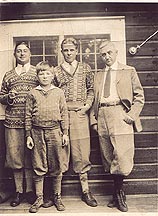
Born in Johnstown, he attended Union College and received his MD from the College of Physicians and Surgeons of Columbia University in 1899. He went on to become the head of the Carnegie Institution in Washington Department of Embryology and a Professor of Anatomy at Johns Hopkins in Baltimore. His contributions to the field of Embryology earned him international recognition including an honorary doctorate from Trinity College, Dublin. His mother, Hannah Green Streeter, gave him land to build a camp on the south shore in 1923. Members of his family have returned every year since to the camp, Fickle Brook.
Barbara McMartin, 1931-2005
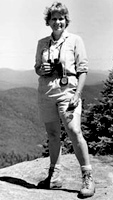 She was brought up in Johnstown. Her father, D. Malcolm McMartin, was a local physician. Her mother was Barbara Clark McMartin. After completing a PhD in mathematics from the City University of New York in 1972, Barbara turned her interests to the environmental movement in the Adirondacks. Until her death, she was a tireless advocate for the Adirondacks. She wrote 25 books dedicated to the region including a popular series of guide books. She also wrote histories of the region especially focusing on the interconnection of natural resources and economic and social growth in books like Hides, Hemlocks and Adirondack History. Her contributions were recognized by numerous awards including a Founder’s Day Award from the Adirondack Museum in Blue Mountain Lake. Barbara was a summer resident of Canada Lake since childhood and eventually became a year round resident with her husband Alec Reid. Her love of the Adirondacks was instilled in her children and grandchildren.
She was brought up in Johnstown. Her father, D. Malcolm McMartin, was a local physician. Her mother was Barbara Clark McMartin. After completing a PhD in mathematics from the City University of New York in 1972, Barbara turned her interests to the environmental movement in the Adirondacks. Until her death, she was a tireless advocate for the Adirondacks. She wrote 25 books dedicated to the region including a popular series of guide books. She also wrote histories of the region especially focusing on the interconnection of natural resources and economic and social growth in books like Hides, Hemlocks and Adirondack History. Her contributions were recognized by numerous awards including a Founder’s Day Award from the Adirondack Museum in Blue Mountain Lake. Barbara was a summer resident of Canada Lake since childhood and eventually became a year round resident with her husband Alec Reid. Her love of the Adirondacks was instilled in her children and grandchildren.
